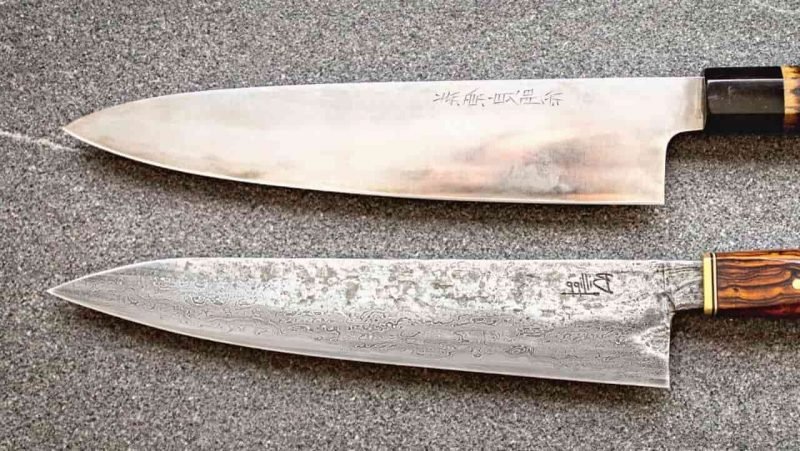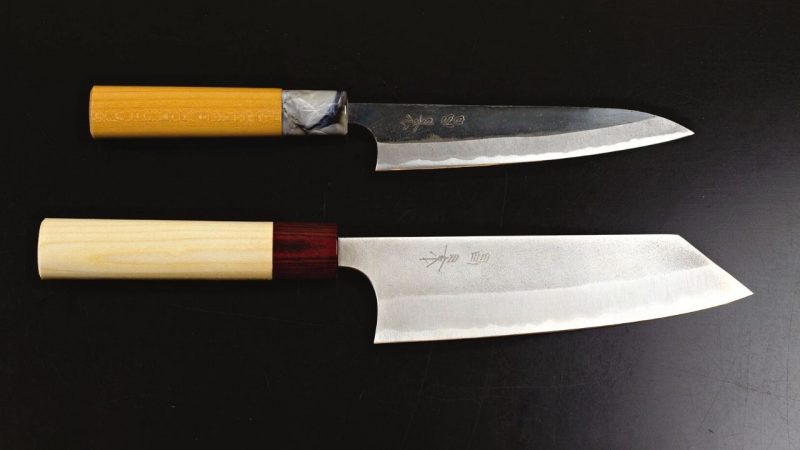A good chef, hunter, or knife enthusiast… Everyone loves a tough, long-lasting knife. A carbon steel knife fits your wants quite nicely there. But a Carbon Steel Knife asks for your attention more often. Carbon Steel Knife care includes wiping and rinsing every 5 minutes. And without proper care, you may not get enough benefits out of them. You’re not going to enjoy that experience.
Now, the questions naturally pop up in your mind – “How can I care for my Carbon Steel Knife? Should I use a Carbon Steel Knife?”
We are going to answer all these curious questions with some tips for you. Let’s get started.
Upside & Downside of Carbon Steel Knife
To use everything comfortably, you have to know its strengths & weaknesses first. That way, you will understand where you should and should not put your stuff to use. So let’s dig deeper into Carbon Steel.
A good Carbon Steel Knife with medium carbon density comes 0.3-0.59% or a high carbon density of 0.6-0.99%. The Higher the carbon density percentage is, the sturdier the blade of the knife will become.

Carbon Steel Knife is hard but easy to sharpen at the same time. And the sharpened edge of Carbon Steel is sharper than most other materials, which lasts for a long time. So if you are chopping foods, you won’t have to sweat to get a fine, slim cut. That’s the key reason for both the bladesmith & chefs to love Carbon Steel. You see, most of the pro chefs choose carbon steel knives over other material-built knives. Once you build the Patina layer over the knife, your knife will become quite comfortable to care for. And then, your knife can serve you for a very, very long time. Carbon Steel Knife is environment-friendly too, as it’s easily recyclable. One other feature you will really like about it. A Carbon Steel knife is cheaper than most other material-built knives.
But before building the Patina, your knife is very susceptible to rust. When you use it in the kitchen, it will find a nasty environment with water & moisture there. So You’ll have to continuously wipe clean and keep it dry, almost after every use.
Carbon Steel Knife vs Stainless-Steel Knife
Carbon Steel is traditionally making cutlery components, and that is for centuries now. Bladesmith used to make high-quality knives, swords, repair parts, automotive parts, etc. Even in the old days, Samurai swords were made out of High Carbon Steel. The reasons behind such reliability are durability, sharpness, toughness & environmental friendliness it provides.

Modern Stainless-Steel joined the race to take over the reign from Carbon Steel. Stainless-Steel is not susceptible to water. But Carbon steel-made blades and other components still hold ground because of the attributes it offers.
A Stainless-Steel knife can guarantee you safety from water. In the kitchen, you need to soak your knife every now & then. You can not afford to wipe the knife clean every time you use your knife there. So, a Stainless knife can be your loyal companion in the kitchen. Stainless-Steel can be easier to maintain at first, but can not provide the firmness, stability that Carbon Steel can offer in the long run. As the sharpness wears off fast, you will have to sharpen a stainless-steel knife more than once every year. In a professional kitchen, where the quality of your slicing may matter, you should not use a dull knife there. You will need to keep a knife there that stays sharp.
Here we can conclude a thing now. You can use a Stainless-steel knife for hassle-free regular uses. But when you are putting your knife to more serious use, a Carbon Steel knife will be the best choice.
Should I choose a carbon steel knife? Or Stainless Knife? – if you had this question, hopefully, you got the answer.
Procedures for Carbon Steel Knife Care
The biggest problem you will face while using a Carbon steel knife is rust. Rust is a brownish or reddish iron oxide component. It forms over the steel surface in the presence of moisture or water. Rust catches on Carbon Steel Knife quite fast as it has no protective layer on the surface.

So you take good care of your knife and save some trouble. Let’s see how your Carbon Steel Knife care procedures should be:
- Always keep your knife clean & dry, after every cut or in every 4-5 mins. Use normal water & a towel to do so. This way, rust can’t form on your knife.
- Regardless of how dirty your knife gets, never go hog-wild on your knife while washing. You will end up damaging your knife & its edge a bit that way. Handwashing is the best option here. But you can use steel wool on it but scrub gently.
- Develop Patina as soon as possible. You may ask,” What is Patina?” When you are using a Carbon Steel Knife, you may notice that your knife is staining as it’s getting older. You are careful with your knife, yet you are experiencing this situation. It’s because Carbon Steel Knives tend to build patina over the surface.
This patina is also another kind of Iron Oxide, like rust. But it strengthens & protects your knife from rust. Also, patina doesn’t leave a bad taste on your food as rust on a knife does. So Patina is a harmless friend of your knife, just you’ll have to sacrifice the glossy look.
- Are you planning not to compromise your knife with Patina or Rust? There is no guarantee that you can keep your knife away from the patina forever. But to slow down the patina building process, try not to use your Carbon Steel Knife on cutting any acidic food, such as lemon, orange, apple, cabbage, onion etc.
Acid fastens the rusting or patina process. So if you cut any acidic food, then rinse the knife off with water asap.
- Avoid using hot water and dishwashing soap on the knife unless you’re intentionally trying to get rust or patina on your knife.
- Never keep your knife soaked. In a short time of contact with water & humidity, like 10 minutes, your knife will start to catch rust. Again, if yours got a wooden or pakkawood handle, it’ll receive some damage as well.
- Be warned of cutting through bones, frozen foods, coconuts, or firmly dense items. They damage the edge of your knife, no matter what material your knife came from.
- Always try to cut in an even action and not to twist the blade. Because sideways pressure can easily damage the blade and decentralize the edge.
- Hand Sharpens your Knife. Choosing & Using a good whetstone will make your sharpening a lot easier.
How to Develop Patina on Carbon Steel Knife
Okay. Here is the most important part of your Carbon steel Knife care. You must develop a Patina in order to skip all those caring procedures. But how are you going to develop patina film on your knife fast?
We’re borrowing an old process from Shotgun making, where hard Patina was developed by intentionally rusting the steel. This method is the quickest and easiest to follow. The name of this method is Rust Bluing. In case your knife caught some rust, you are halfway there already.
This method stands on simple chemistry. You see, the rust, chemical name hematite, comes with the formula “Fe2O3”. When you agitate hematite in the presence of Hydrogen, you’ll get Fe3O4, chemically known as Magnetite, and we know it by the name Patina.
Boiling water is a good source of Hydrogen and to agitate Hematite, a.k.a. rust on your knife. Then their chemical reaction will bring Magnetite a.k.a. grayish patina in place of rust. And each pair of Hydrogen takes an Oxygen molecule with them to form a molecule of water, as a by-product of the reaction.
Now let’s get down into the procedure. If you don’t have rust on your knife, then you can wait for it to rust. Or you can forcefully rust your knife as well. You already know how you can get rust over your blade. So, by using dishwashing soap, keeping it wet, and the things you are not supposed to do to your knife, you can easily catch all over your blade. But do those only to the blade, not the handle.
When your knife has rust on it, get ready for the next step. Sink the knife into boiling water up to the bolster, not the handle. In that case, you should take an asparagus pan and boil some water. An asparagus pan is pretty deep, and you can put really large knives like chef’s knives in them without immersing the handle.
Now leave the knife there, wait for 10 minutes. Take the knife out of the water. You’ll see a grayish patina has replaced rust. Some residual rust may sit there. Simply put a little soap and softly scrub the rust away with steel wool.
After building patina on the whole blade, you can use olive oil to keep your carbon knife fit to use. From that point on, your knife is the best knife in the world.

